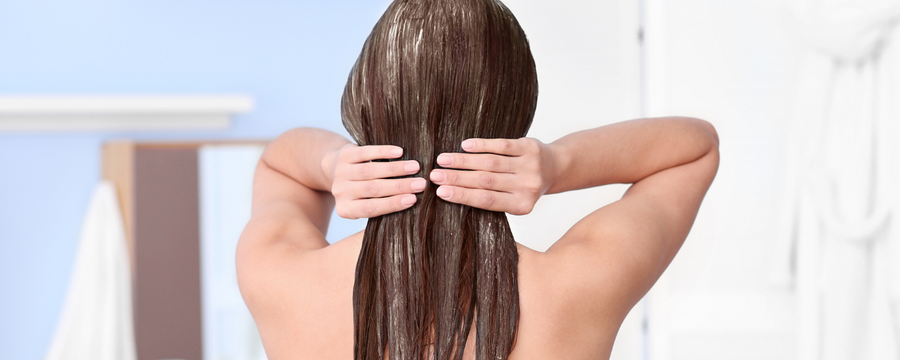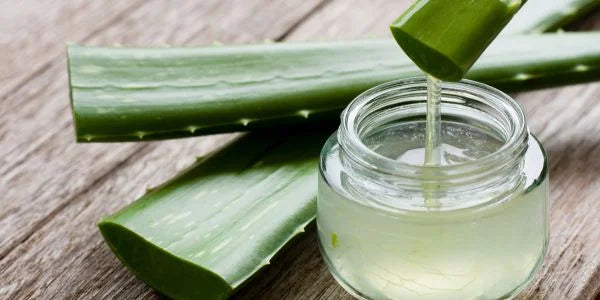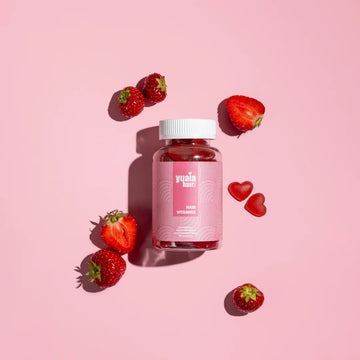
Moisturizing hair masks and treatments: How to strengthen your strands
by Lotte Lindgren on Sep 27, 2023

Read through by Dorthe Kristensen
Hairdresser and former co-owner of the award-winning hairdressing chain Zoom by Zoom
With many years of experience in the hairdressing industry, Dorthe has advised many customers about hair and hair care. Dorthe has read through this blog entry to ensure high quality and professionalism. This blog post is professionally updated on March 30, 2025.
Table of contents
The health of the hair strands is essential for beautiful and shiny hair. A moisturizing hair treatment can be a great way to strengthen your strands, resulting in a more shiny and well-groomed look. In this article, we will explore what a moisturizing hair treatment really is, how to use it correctly, as well as introduce you to the best moisturizing hair treatment on the market. We'll also share some extra tips to strengthen your strands and give them the attention they deserve. So let's dive into the world of moisturizing hair treatments!
What is a moisturizing hair mask or treatment?
Moisturizing hair masks or treatments adds extra moisture and nourishment to the hair. They are particularly suitable for dry and damaged hair, as they help rebuild and strengthen the hair's structure. A good moisturizing hair treatment can help prevent split ends and make hair softer and shinier. With regular use, a moisturizing hair regimen can contribute to healthier and more resilient hair.
Some types of moisturizing hair treatments contain natural ingredients such as argan oil or shea butter, which have proven properties in relation to providing intense hydration to the hair. Other treatments contain active proteins that penetrate deeper into the hair structure to repair damage at a molecular level.
If you’re seeking the best moisturizing hair mask, consider those that include ingredients like hyaluronic acid or aloe vera. These components are known for their ability to lock in moisture, leaving your hair soft, smooth, and full of life.
Whichever type you choose, an effective moisturizing hair regimen will leave your dry or damaged hair revitalized and healthy again.

What are the benefits of using a moisturizing hair mask or treatment?
A moisturizing hair mask or treatment can have many benefits for your hair and scalp. Here are some of the main benefits of using a moisturizing hair regimen:
1. Increased moisture: A moisturizing hair treatment helps to add and retain moisture in the hair. This is especially important for people with dry or damaged hair, as it can make the hair more shiny and soft.
For hair that struggles with extreme dryness, combining a moisturizing hair mask with a nourishing leave-in treatment can deliver long-lasting hydration and restore elasticity to brittle strands.
2. Damage Repair: If your hair has been damaged by heat styling, colouring, bleaching or other chemical treatments, a moisturizing hair treatment can help repair and rebuild it. It can also prevent further damage and protect the hair from future damage.
Using a moisturizing hair mask regularly strengthens the hair shaft, reducing breakage caused by repeated chemical treatments or styling tools. Treatments enriched with proteins like keratin help rebuild the internal structure of damaged hair for smoother, stronger strands.
3. Prevention of split ends: A moisturizing hair treatment can prevent split ends by nourishing and strengthening the hair. This can extend the time between hairdresser visits and preserve the length of the hair. If you suffer from split ends, we can recommend our guide to the problem here.
For best results, use a moisturizing hair mask focused on sealing split ends, followed by a lightweight hair oil to lock in moisture and prevent further splitting. Regular trims combined with targeted treatments will keep your ends healthy and your hair looking vibrant.
4. Softening and smoothing: If your hair is coarse, frizzy or difficult to style, a moisturizing hair treatment can help soften and smooth it. It can make your hair easier to style and leave it smoother and more manageable.
Hair masks enriched with shea butter or argan oil are particularly effective at taming frizz, adding softness, and improving manageability. For an extra smoothing boost, consider pairing your mask with a leave-in conditioner that provides added hydration throughout the day.

Types of moisturizing hair masks or treatments
Leave-in conditioner: Effective for daily care. A leave-in conditioner is a moisturizing hair treatment that can be left in the hair all day. It helps maintain and restore moisture in dry hair and at the same time strengthens the hair structure. Read our big guide to leave-in conditioner here.
Leave-in treatments are perfect for maintaining hydration between washes. They provide a lightweight layer of moisture, keeping your strands soft, manageable, and protected from daily wear and tear.
A leave-in conditioner is an effective moisturizing hair treatment that can be left in the hair all day and strengthens the hair structure.
DIY moisturizing hair masks with natural ingredients: DIY hair treatments are a great way to give your dry hair the moisture it needs without using chemicals or unwanted additives. Natural ingredients such as avocado, coconut oil and honey help to nourish and strengthen the hair in depth.
Intensively treating hair masks: For deeper repair. These types of moisturizing hair treatments contain concentrated active ingredients that penetrate deep into the hair to repair the damage from within. They are ideal for those who have very dry or damaged hair and want intensive care to restore the health and strength of their locks.
Intensive moisturizing masks are particularly beneficial for chemically treated or heat-damaged hair. Look for masks with ingredients like keratin, hyaluronic acid, or argan oil, as they help rebuild and strengthen hair while delivering long-lasting moisture.
How often do you use a moisturizing hair treatment?
How to use a moisturizing hair mask or treatment
1. Start by cleaning your hair thoroughly using a mild shampoo.
2. Apply the hair mask or treatment evenly to the hair, from root to tip.
3. Leave the hair mask or treatment on for 10-15 minutes for optimal moisture care.
4. Rinse the treatment thoroughly with warm water and style the hair as desired.
If you follow these steps regularly, your moisturizing hair regimen will strengthen your strands and give them the care they need to maintain a healthy and shiny look.
Step 1: Cleanse your hair
Choose a mild and moisturizing shampoo to clean your hair. Massage the shampoo into the hair and scalp to remove dirt and product build-up. Rinse thoroughly with lukewarm water to ensure all shampoo is removed.
Using a moisturizing shampoo as a first step ensures that your hair is clean and primed to fully absorb the benefits of a moisturizing hair mask.
Step 2: Apply the hair mask or treatment
Choose a moisturizing hair mask or treatment suitable for your hair type. Distribute the treatment evenly throughout the hair, from root to tip. Use a wide-toothed comb or brush to distribute the treatment optimally.
If you're applying a moisturizing hair mask, focus on the mid-lengths and ends, where dryness is often most pronounced. For leave-in treatments, ensure the product is lightweight enough to avoid weighing down fine hair while still delivering moisture.
Step 3: Let the hair treatment work
Cover your hair with a shower cap or plastic bag so that the hair mask or treatment can penetrate better into the hair and have an improved effect. Leave the treatment on for at least the recommended time for optimal effect.
For an intensive moisturizing hair mask, leaving it on for 20-30 minutes allows the active ingredients to deeply hydrate and repair your strands. For lighter treatments, 10-15 minutes may be sufficient to achieve noticeable softness and shine.
Avoid exposing the hair to heat during the treatment process, as this can damage and dry out the hair.
Step 4: Rinse out the treatment
Rinse thoroughly with plenty of lukewarm water to remove all the product from the hair. Make sure there is no conditioner left in the hair. After rinsing, gently rub excess water out of hair.

How often should you use a moisturizing hair mask or treatment?
A moisturizing hair mask or treatment is an important part of any hair care routine as it helps restore moisture balance and strengthen the hair. However, how often you should use a moisturizing hair treatment depends on several factors, including the condition and needs of your hair type.
In general, it is recommended to use a moisturizing hair mask or treatment at least once a week. If you have dry or damaged hair, it can be beneficial to use it twice a week or even every time you wash your hair. In this way, you can maintain a healthy moisture balance and supply the hair with the necessary nutrients. If you have dry hair, we have put together a guide to hair treatments for dry hair here.
However, it is important to pay attention to the condition of your hair and react to any changes. If your hair starts to feel heavy or greasy after using a moisturizing hair treatment, it could be a sign that you are using it too often. In that case, it may be a good idea to reduce the number of times you use the hair treatment.
That way you can find the right balance and give your hair the optimal care it needs.
How do I choose the right moisturizing hair mask or treatment?
When choosing a moisturizing hair mask or treatment, it is important to choose one that is suitable for the needs of your hair type. There are different types of hair treatments on the market that are formulated for different hair types and problems. Here are some tips for finding the right moisturizing hair regimen:
1. Identify your hair type's needs: Analyze your hair and identify its needs. Do you have dry, damaged or colored hair? Do you have curly or fine hair? By knowing the needs of your hair type, you can choose a hair regimen that is specially developed to meet these needs.
2. Read the list of ingredients: Pay attention to the ingredients in the hair treatment. Avoid products containing sulfates and parabens, as these can dry out the hair and irritate the scalp. Instead, choose products that contain natural and nourishing ingredients such as argan oil, coconut oil or aloe vera.
3. Follow the instructions: Read and follow the instructions on the hair treatment packaging carefully. Some hair treatments should be left in the hair for a few minutes, while others should be rinsed out immediately. It is important to follow the directions for best results.
4. Ask for recommendations: If you are in doubt about which moisturizing hair treatment best suits your hair type's needs, you can always ask for recommendations from a professional hairdresser or beautician. They have experience with different products and can help you find the right hair regimen.
What ingredients are in a moisturizing hair mask or treatment?
A moisturizing hair mask treatment typically contains a number of ingredients that help rebuild and care for the hair. These ingredients work together to add moisture to the hair, leaving it soft, shiny and healthy. Here are some of the most common ingredients you can find in a moisturizing hair treatment:
1. Glycerin: Glycerin is a moisturizing ingredient that attracts and binds moisture to the hair. It helps prevent dryness and makes hair more supple.
2. Aloe vera: Aloe vera is known for its moisturizing properties. This natural ingredient helps to soothe and hydrate the hair while providing nourishment.

3. Argan oil: Argan oil is rich in essential fatty acids and vitamin E, which help maintain and restore the moisture balance in the hair. This oil is also known to leave hair soft and shiny.
4. Shea Butter: Shea butter is an oily ingredient known for its moisturizing properties. It penetrates deep into the hair and leaves it soft and smooth.
5. Coconut Oil: Coconut oil is a versatile ingredient that can add moisture and care to the hair. It also has antimicrobial properties that can help fight dandruff and scalp irritation.
6. Hyaluronic acid: Hyaluronic acid is a popular ingredient in skin and hair care. It attracts and binds moisture to the hair, making it more hydrated and shiny.
7. Keratin: Keratin is a protein found naturally in hair. It helps to rebuild and strengthen the hair, while adding moisture and protection.
These are just some of the ingredients that can be found in a moisturizing hair regimen. It is important to read the ingredient list and choose a hair treatment that best suits your needs and hair type.
Best moisturizing hair masks and treatments on the market
Moisturizing hair mask and treatments are essential to strengthen and revive dry and damaged strands.
Repair and Care moisturizing hair mask is undoubtedly the best on the market for several good reasons. This hair mask is a real lifeline for your hair, as it combines intensive moisture and comprehensive care that no other product can match.
Firstly, this hair mask contains Rep'Hair® (0.4%), a magical ingredient that really makes a difference. Rep'Hair® has been shown to reduce damage to the hair's surface by an impressive 62%. This means that even the most damaged hair can begin to recover and become healthier.
Split hairs are a nuisance for many, but with this hair mask you can say goodbye to them. Rep'Hair® reduces split ends by as much as 43%. Your hair will be smoother and more well-groomed, resulting in a beautiful and healthy appearance.
But it doesn't stop here. This hair mask also contains Neossance Hemisqualane, which reduces frizz by 29%. This is great for anyone struggling with unruly locks. And for those who color their hair, Neossance Hemisqualane also provides up to 30% better color protection, which is a bonus.
But it's not just these ingredients that make this hair mask the best on the market. It is also enriched with INCA INCHI Oil, which penetrates deep into the hair and leaves it soft and incredibly well cared for. Mango Butter helps to rebuild the hair and make it more elastic, which is essential to prevent future damage.
Another great thing about this hair mask is that it is suitable for all hair types. Whether you have dry or damaged hair, or just want to give your hair some extra love, you can use this hair mask with confidence.
So in short, Repair and Care moisturizing hair mask is the best on the market because it not only moisturizes your hair, but also repairs it, strengthens it, and prevents future damage. Your hair will shine brilliantly, be less frizzy and overall much healthier. Give it a try and you will see the results for yourself.
How to make DIY moisturizing masks at home
Creating a DIY moisturizing hair mask at home allows you to nourish your hair naturally using effective ingredients. Here are two simple recipes based on ingredients that deeply hydrate and repair your strands:
1. Aloe Vera and Coconut Oil Mask
Ingredients: 3 tablespoons of fresh aloe vera gel and 2 tablespoons of coconut oil.
How to use: Mix the aloe vera and coconut oil until smooth. Apply to clean, damp hair, focusing on dry areas. Leave it on for 20-30 minutes, then rinse with lukewarm water. This DIY moisturizing hair mask hydrates the hair while soothing the scalp.
2. Shea Butter and Argan Oil Mask
Ingredients: 2 tablespoons of shea butter and 1 tablespoon of argan oil.
How to use: Melt the shea butter slightly and mix it with argan oil. Spread evenly through your hair and let it sit for 20 minutes. Rinse thoroughly. This DIY moisturizing hair mask restores moisture, strengthens strands, and enhances shine.
These simple yet effective DIY moisturizing hair masks use natural ingredients to deeply hydrate and nourish your hair, leaving it soft, shiny, and healthier.
Other tips to strengthen your hair strands
A moisturizing hair treatment is an effective way to strengthen your strands. The rich ingredients help rebuild and condition the hair, giving it more elasticity and resilience. With regular use, you can achieve healthier and shinier hair.
In addition to using the best moisturizing hair mask, incorporating a consistent hair care routine with deeply hydrating products will further strengthen your strands and reduce breakage.
Be careful with heat tools such as blow dryers, flat irons or curling irons as they can damage the hair and weaken it. If you cannot avoid using these tools, you should always use a heat protectant spray to minimize damage.
Avoid frequent hair washing
Use a mild shampoo that does not dry out the hair to avoid frequent hair washing. Wash your hair only every other day to preserve its natural oiliness and moisture. Avoid using hot water as it can damage your hair and make it more dry and brittle.

Protect your hair from heat tools
Always use heat protectant spray before using styling tools. Use the lowest possible setting on the heating tools. Reduce the number of times you use heat tools.
- Spray your hair with a heat protectant spray before using styling tools.
- Adjust the temperature of your heating tools to the lowest possible setting to avoid damaging the hair.
- Try to limit the use of heat tools as much as possible to maintain the health and strength of your hair.
Use a moisturizing shampoo and conditioner
Choose products with natural oils and moisturizing ingredients. These help retain the hair's natural moisture and strengthen the strands. Massage shampoo thoroughly into the scalp to stimulate blood circulation, which can promote healthy hair growth. Leave the conditioner in the hair for a few minutes for extra nourishment before rinsing it out.
- Choose products with natural oils and moisturizing ingredients
- Massage the shampoo thoroughly into the scalp to stimulate blood circulation
- Leave the conditioner on the hair for a few minutes for extra nourishment
Get regular haircuts
Make an appointment for a haircut every six to eight weeks. Talk to your hairdresser about getting the ends trimmed to avoid split ends. Allow your hair to grow healthy by regularly removing the damaged parts.

Use a wide-toothed comb
Use a wide-toothed comb or a natural-bristled hairbrush to avoid pulling and breaking the hair. Always start combing the hair gently from the ends and work upwards towards the roots to avoid unnecessary hair loss.
Avoid tight hairstyles
Avoid tightening your hair too much by using elastics or bobby pins. Use soft and flexible hair elastics or hair clips that do not wear and pull the hair unnecessarily.
Take care of your hair when it is wet
Avoid brushing your hair when it is wet as it is more fragile and prone to breakage. Allow hair to air dry or use a microfiber towel to gently absorb excess moisture.
Get a 10% discount code sent to you
Receive the best tips and tricks for your hair from Lotte and Nanna 🥰
 2-5 day delivery
2-5 day delivery
 25.000+ satisfied customers
25.000+ satisfied customers
 Satisfaction Guarantee
Satisfaction Guarantee












